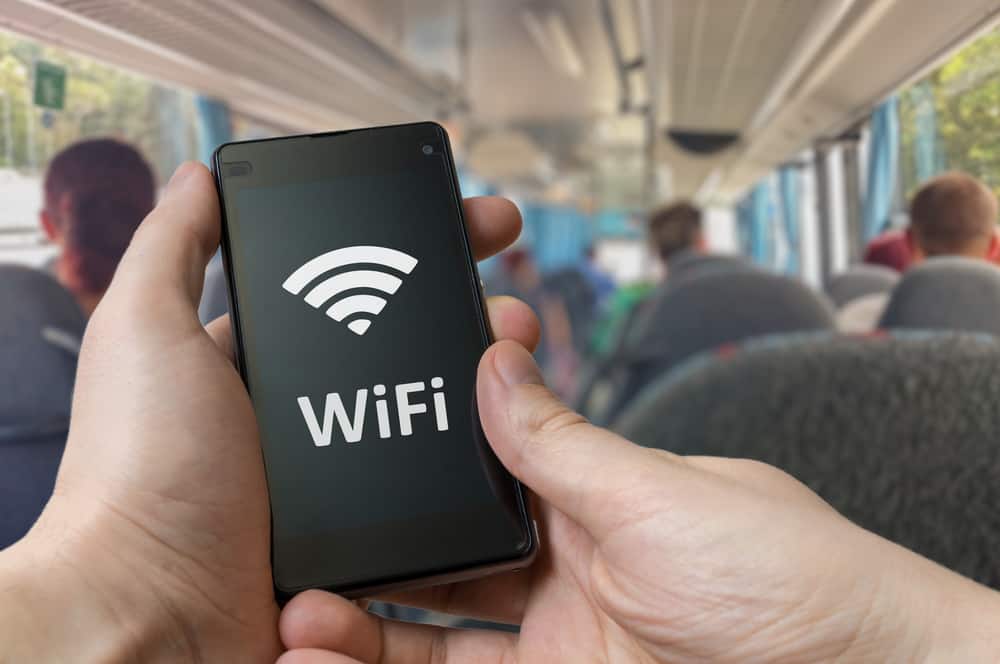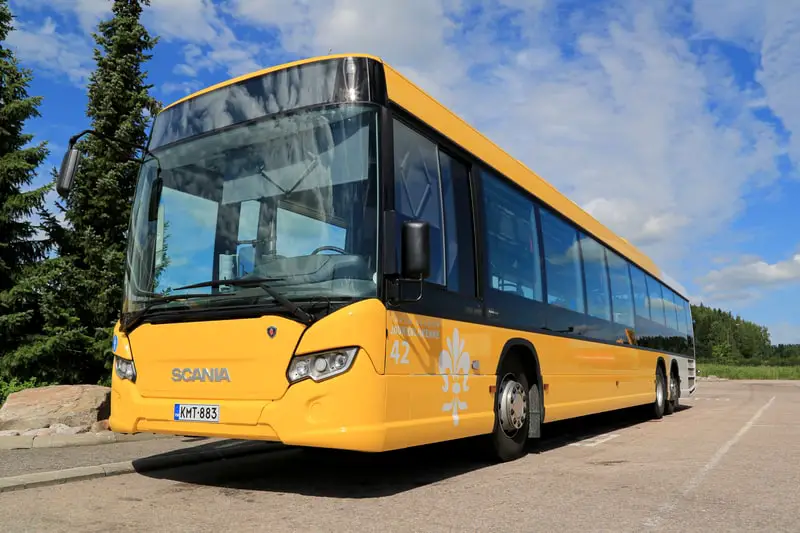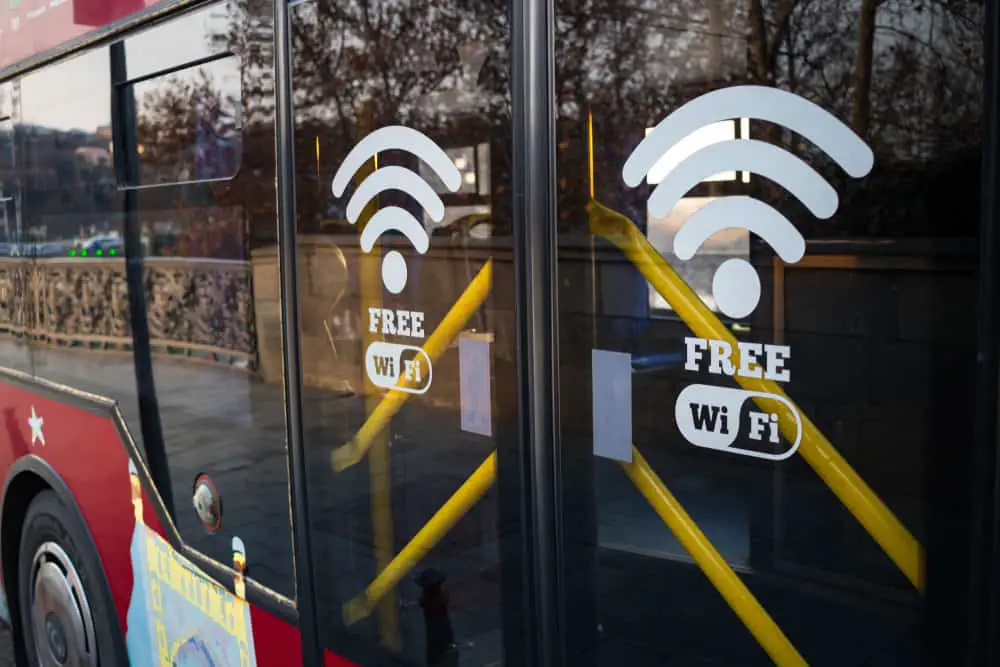
Most of us are more or less permanently attached to our phones and other devices, and most of the time, our digital busyness is legitimate.
We can attend to emails, do some research, update our banking, post our latest news on social media, and much more. A great time to do this is while you’re traveling on public transport, which begs the question: do buses have wifi?
Many transportation companies have installed Wi-Fi in their buses. The vast majority of charter buses provide their customers with wifi access, but some charge an extra fee. In the last decade, school and city buses have begun to provide this added benefit to their passengers.
Modern society is becoming increasingly dependent on the internet and our devices. We run our lives from our phones and laptops, and when we have no internet access, we often feel as if our world has come to a standstill.
When we have to use buses, it’s a bonus to use the bus company’s wifi to go about our business instead of depleting our data.
Wifi On Buses

Most public transport companies have joined the trend of installing wifi onboard, and buses are no exception. The main thing that buses have going for them is that their rates are cheaper than most other forms of transport.
But, even so, bus companies keep searching for extra drawcards to attract more customers. In our ever-connected world, most passengers are happy if wifi is available!
Buses have seen a lot of upgrading and modernization in the last 10-12 years. Coaches and charter buses are at the forefront of kitting their fleets out with wifi and other accessories. Nearly all major bus providers in the USA provide free wifi to their passengers.
Here are the major bus providers in the US and their Wi-Fi availability:
| Bus Provider | Wifi |
|---|---|
| Greyhound | Yes (Free Wi-Fi up to 100MB) |
| Adirondack Trailways | Yes (Free Wi-Fi) |
| Jefferson Lines | Yes (Free Wi-Fi) |
| Peter Pan | Yes (on most buses) |
| RedCoach | Yes (Free Wi-Fi) |
| Barons Bus | Yes (Free Wi-Fi) |
| BestBus | Yes (Free Wi-Fi) |
| OurBus | Yes (Free Wi-Fi) |
| Go Buses | Yes (Free Wi-Fi) |
| Southeastern Stages | Yes (Free Wi-Fi) |
Previously there were no wifi connections, USB ports, or outlets on private or public buses, but today you can plan a long bus trip to the middle of nowhere and know that you’re connected and can charge your devices before they die.
A 2013 survey about the importance of wifi on buses shows that in 2011 only 1.4% of the country’s buses had wifi availability. But 45.7% of riders considered it an important factor when finalizing their travel plans.
Although the survey is old, it was a clear indication that the public wants and needs wifi on buses to continue working, use social media, or entertain themselves on long trips.
Since approximately 2017, city buses have gradually started equipping their vehicles with wifi at the request of their customers who are constantly working or entertaining themselves via the internet.
The Benefits Of Wifi On Buses
While some argue that people should set their devices aside sometimes and interact with people face-to-face, wifi on buses still benefits both passengers and bus companies.
- Riders stay entertained by watching movies, playing games, surfing the net, and reading the news without using their own data.
- Free wifi improves the rider’s experience on the bus, encouraging them to continue using this mode of transport.
- It allows passengers extra time to work, compared to the time they would lose while commuting in a private car.
- Bus companies can use the data to analyze passengers’ data and integrate it with their marketing strategies, e.g., keeping track of how often, where, and what time passengers log onto the wifi. This will enable the bus company to recommend routes and special deals to passengers.
Do School Buses Have Wifi?

In May 2020, School Transportation News polled more than 500 leading transportation providers and discovered that 13% had rolled out wifi on some or all of their buses. A further 19% intended to add student wifi in the following school year.
The Benefits Of Wifi On School Buses
While the addition of student wifi to school buses might be progressing more slowly than other buses, the benefits will hopefully encourage the bus providers to speed up the process.
School Bus Wifi Can Aid Students’ Academic Success
It enables kids to spend more time doing homework and studying while traveling to and from school or sports activities.
For students who don’t have the internet at home or have after-school responsibilities outside the home, their school trips might be the only opportunity to work on online assignments.
Sometimes schools are forced to close, e.g., hurricanes, the coronavirus outbreak, or snow days, and lessons have to shift to online platforms. Students with no access to the internet struggle to keep up.
But school districts can use their wifi-equipped vehicles as community hotspots. They can park them in public areas so that such students can access the wifi and continue lessons.
School Bus Wifi Increases Safety
When students have something to keep them busy (and they love using the internet), they are more inclined to stay out of trouble.
In a pilot program in Raytown School District, where they introduced wifi on six buses, disciplinary referrals decreased by 45%. Another program in Aurora Public Schools District saw a massive 75% decrease.
When students are engaged in an activity and remain seated, all onboard have a safer experience.
Connecting School Bus Technologies
Wifi on school buses also benefits the service provider. They can use it to connect any bus technology that needs internet connections, such as GPS, cameras, drivers’ tablets, and telematics.
How Wifi On Buses Works

Buses have wireless access points or routers that supply the wifi signal. They then use cellular connections to link the internet service to the router.
How Safe Is It To Use The Bus Wifi?
Bus Wifi is a public connection that people often use without giving it a second thought, but there are some dangers linked to using public wifi networks.
One of the most common dangers of public wifi is Man-in-the-Middle Attacks (MiTM). It amounts to an invasion of privacy where an attacker gets between two devices communicating with each other.
For instance, the attacker could sit between two people sending emails to one another, reading their private messages – which are no longer private!
Cybercriminals can also buy devices and kits to enable eavesdropping on wifi signals. This gives them access to everything a user does, including capturing login details or viewing web pages. They can then even log in to your bank account. Users will never know that anyone is sniffing and snooping.
Hackers can use public networks to release malware. They can also inject malware into your device by writing code for a specific software weakness.
Alternatively, they cause pop-ups to appear while connecting to the wifi. When you click on the pop-up, it immediately downloads malware onto your device. These will recommend upgrading to some popular software.
We have to conclude that using these public wifi connections is not safe. However, you can mitigate this situation by trying the following:
- Using a VPN will create an encrypted and secure connection for privacy purposes.
- You should disable file sharing on your system.
- Enable the option “always use HTTPS” on websites you use often or those that need credentials.
- Disable your wifi when you’re not using it.
- Turn off your Bluetooth.
- Don’t allow automatic connections to public networks.
- Don’t use websites that require your personal data, such as your bank account.
- Don’t use networks that are not protected by passwords.
Conclusion
Many buses have wifi these days, especially in comparison to a decade ago. They tend to create a positive traveling experience for all concerned, especially for those making long trips or school children using it for academic purposes.
Public wifi also has its risks that open passengers up to cyber attacks, so they should take steps to protect themselves and enjoy the perk until they park.
